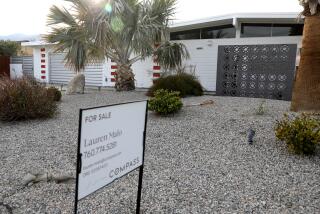TV Advertising’s Stepchild : Infomercials: No Respect but Clients Are Asking for Them
- Share via
IRVINE — Jan West holds a piece of paper at arm’s length and wrinkles her nose as if the paper stinks.
That’s how most advertising agencies look at the infomercial, says West, who buys TV time for the medium. “They think it’s sleazy. They actually have an attitude.”
Infomercials--30-minute programs intended mainly to sell a product or service--are the Rodney Dangerfield of television: They get no respect. For most of the viewing public, they call to mind spots for food-preparation gadgets, miracle weight-loss plans and spray-on “hair” to cover bald spots.
But they are a cousin in a media family that experts say is revolutionizing television. And ad executives at conventional ad agencies, West says, may soon wake up to find that they have missed out by discounting infomercials.
“Some of the majors are trying to get into this now because their clients are asking for it,” said West, senior account executive with Williams Television Time. The company, based in Santa Monica, is the nation’s largest independent infomercial producer and the biggest buyer of TV time for infomercials.
Infomercials were a $1-billion industry last year, according to the National Infomercial Marketing Assn. in Washington. That breaks out as $250 million in TV time purchased and $750 million in product sales. Experts estimate that the industry could be worth $10 billion by 1998.
*
There are 175 infomercials scheduled to air this year, the association said, double the number just five years ago.
An infomercial can be produced for about $100,000, West said, and costs another $30,000 to $50,000 to test-market. If the test draws a satisfactory response, the client will begin with a “slow rollout,” West said, spending about $50,000 a week for air time.
On smaller cable stations, West said, infomercial time can cost as little as $1,000 for each half hour.
The infomercial is part of what is known as direct-response television: commercials that use “800” or “900” phone numbers to draw a response from viewers. The category includes commercials of two minutes or less and home shopping programs.
Lately, the medium has been getting considerably more respect.
*
Ross Perot, for example, used an “800” number and 30-minute format last fall to advertise his presidential campaign. Bell Computers, Armor All and Chrysler have produced infomercials. In the planning stages are productions for Revlon, Estee Lauder, Merle Norman and the Hollywood chapter of Mothers Against Drunk Driving.
Also, big names in advertising are opening direct-response divisions. Among them are Western International Media, Ogilvy & Mather, Young & Rubicam, BBDO and Lord Dentsu.
But the issue of credibility remains.
An infomercial selling a rub-on cream that “melts” cellulite was pulled from the air a few years ago after the Food and Drug Administration questioned its claims, said Rader Hayes, a professor of advertising at Marquette University in Milwaukee. Recently, she said, she has seen it back on the air--this time in Spanish.
Infomercials were “chugging away, then Ross Perot gave them a big shot in the arm,” Hayes said. “They are becoming more reputable, but that doesn’t mean the whole genre or all infomercials can be accepted at face value. They are especially difficult to monitor if they are run locally” as opposed to nationally.
*
At a trade show in Irvine this week, evidence of the infomercial industry’s odd history lingered. The show, sponsored by Response TV magazine in Capistrano Beach, drew 70 exhibitors and about 600 attendees.
At one exhibit, Dionne Warwick was shown in video promoting Psychic Friends Network, a “900” number service that charges $3.99 a minute. At another, the National Infomercial Marketing Assn. handed out descriptions of its ethics certification program.
“The industry is changing quite a bit,” said Kathleen Kelly, who attended the show to find investors. Her goal is to raise $1 million to produce a set of videotapes and an infomercial, “The Fast-Track Yoga Workout.”
She said she admires the infomercials of positive thinker Anthony Robbins and weight-reduction guru Susan Powter.
“I think America is ready for this,” Kelly said.
Operators Are Standing By ...
Infomercials were a $1-billion business in 1992 and could be worth 10 times that amount by 1998, industry experts say. The 10 that ran most frequently nationwide in February, the latest month for which figures are available:
Program Host Product or Service Psychic Friends Dionne Warwick One-minute call Stop the Insanity Susan Powter Diet tapes Focus on Beauty III Cher Hair-care products Cross Walk Peggy Fleming Exercise equipment Video Professor Jeff Conaway Computer learning video The Principal Secret Victoria Principal Skin-care products Medicus Ray Murray Hinged golf clubs Firmflex Jake Steinfeld Home gym Flying Lure Jim Caldwell Fishing lures Carleton Sheets Carleton Sheets Real estate course
Program Selling price Psychic Friends $ 3.99 Stop the Insanity 79.80 Focus on Beauty III 39.95 Cross Walk 699.30 Video Professor 79.95 The Principal Secret 89.95 Medicus 159.95 Firmflex 149.00 Flying Lure 39.95 Carleton Sheets 159.95
Sources: Response TV magazine, Jordan Whitney Inc.
More to Read
The complete guide to home viewing
Get Screen Gab for everything about the TV shows and streaming movies everyone’s talking about.
You may occasionally receive promotional content from the Los Angeles Times.






